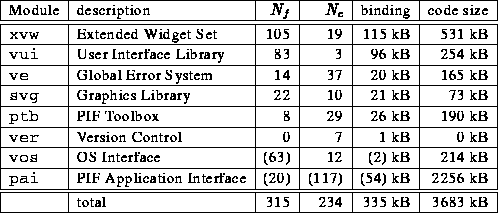4.3.3 Linking <i>XLISP</i> with Framework Components





Next: 4.3.4 LISP Code
Up: 4.3 Implementation
Previous: Reusing the Callback
To provide a homogeneous procedural interface and programming environment,
the X Windows interface of XLISP (VISTA UI Bindings in
Figure 3.1) for XLISP has been put on a set of procedures.
Writing interface code in order to make a C function accessible
from within LISP is a tedious and error-prone task.
As there are many other C-coded parts
of the framework which need to be accessible on the extension language
level, a general automatic method for linking given functions with the
XLISP interpreter and for making them available on the LISP level
has been implemented. This automatism is part of the general
Tool Abstraction Concept (TAC).
This automatic support greatly facilitates the
extension of the XLISP interpreter, as
the programmer is no longer required to understand the XLISP
interpreter in order to extend it with C-coded primitives.

Table 4.1: Number of functions ( ), number of constants (
), number of constants ( ), size of
code for the XLISP interface, and module size of every module that is linked
with the XLISP interpreter. Numbers in parentheses indicate manual binding,
all other code is generated automatically.
), size of
code for the XLISP interface, and module size of every module that is linked
with the XLISP interpreter. Numbers in parentheses indicate manual binding,
all other code is generated automatically.
The source code
size of the original XLISP interpreter (Version 2.1) is roughly 270 kB.
Some specific extensions have been made to the interpreter,
mainly for event handling and for introducing miscellaneous
operating system interface code, like for process control (for running
simulators), and other features which are needed for TCAD
purposes. These manually coded extensions increase the source code
size of the interpreter to 470 kB.
The source code required for LISP bindings of framework
modules which
are required on the task level is currently 335kb (see 4.1), but is steadily increasing.
Modules indicated by parentheses in Table 4.1 are
manually bound to the interpreter. The majority of the interface
code (63 %) is generated automatically during the build phase of
VISTA, using the Tool Abstraction Concept.
335kb (see 4.1), but is steadily increasing.
Modules indicated by parentheses in Table 4.1 are
manually bound to the interpreter. The majority of the interface
code (63 %) is generated automatically during the build phase of
VISTA, using the Tool Abstraction Concept.





Next: 4.3.4 LISP Code
Up: 4.3 Implementation
Previous: Reusing the Callback
Martin Stiftinger
Thu Oct 13 13:51:43 MET 1994

 ), number of constants (
), number of constants ( ), size of
code for the XLISP interface, and module size of every module that is linked
with the XLISP interpreter. Numbers in parentheses indicate manual binding,
all other code is generated automatically.
), size of
code for the XLISP interface, and module size of every module that is linked
with the XLISP interpreter. Numbers in parentheses indicate manual binding,
all other code is generated automatically.




